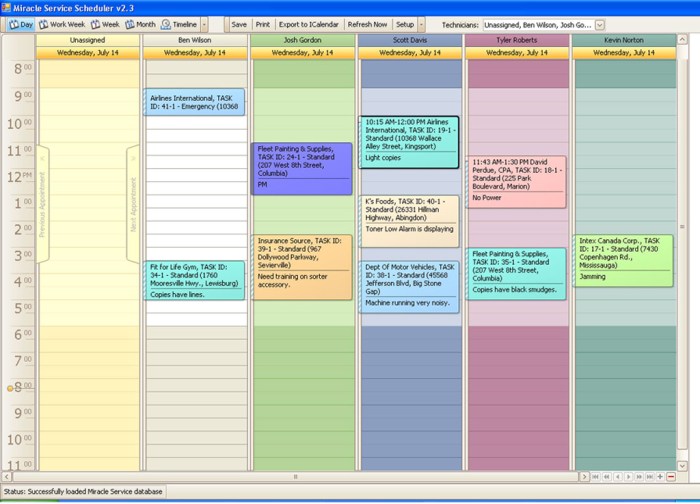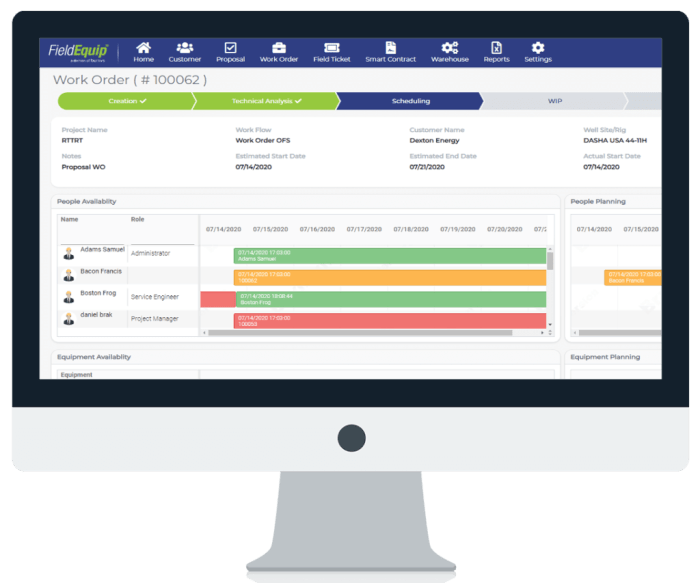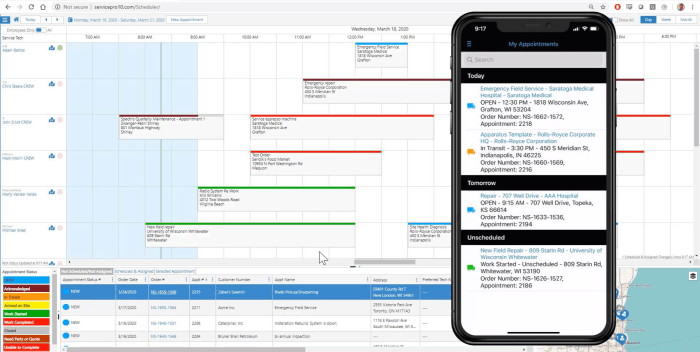Scheduling Software for Field Technicians: Streamline Operations
Originally posted 2024-11-15 01:00:00.
Scheduling Software for Field Technicians is a game-changer for businesses that rely on a mobile workforce. Imagine a world where technicians are dispatched efficiently, appointments are managed seamlessly, and customer service is elevated to new heights. This is the reality that scheduling software brings to the table, offering a suite of powerful features designed to optimize field operations and empower technicians to deliver exceptional results.
By centralizing scheduling, dispatching, and communication, this software transforms the chaos of managing field technicians into a streamlined and organized process. It eliminates the manual headaches of juggling appointments, coordinating routes, and tracking technician availability, freeing up valuable time for both technicians and management.
The benefits extend far beyond improved efficiency, impacting customer satisfaction, resource allocation, and overall business profitability.
The Need for Scheduling Software

Field technicians are the backbone of many businesses, responsible for providing on-site services and ensuring customer satisfaction. Without the right tools, however, their work can be chaotic and inefficient, leading to missed appointments, wasted time, and frustrated customers. Scheduling software specifically designed for field technicians offers a much-needed solution, streamlining operations and boosting productivity.
The Challenges Faced by Field Technicians Without Scheduling Software
Field technicians often face a range of challenges when they lack a dedicated scheduling system. These challenges can significantly impact their efficiency and the overall success of their work.
- Manual Scheduling:Field technicians often rely on manual methods like spreadsheets or paper calendars for scheduling. This can lead to errors, double bookings, and difficulty in tracking appointments.
- Poor Communication:Without a centralized system, communication between technicians, dispatchers, and customers can be fragmented. This can result in missed appointments, delays, and customer dissatisfaction.
- Inefficient Routing:Manually planning routes can be time-consuming and inefficient. Without optimized routes, technicians spend more time on the road, reducing their productivity and increasing fuel costs.
- Lack of Real-Time Visibility:Field technicians may struggle to access real-time information about their schedules, appointments, and customer details. This can lead to confusion and delays.
- Difficulty in Tracking Performance:Without proper tracking tools, it’s difficult to monitor technician performance, identify areas for improvement, and measure the effectiveness of scheduling practices.
Benefits of Scheduling Software for Field Technicians and Their Companies
Scheduling software for field technicians offers a range of benefits, enhancing efficiency, productivity, and customer satisfaction.
- Streamlined Scheduling:Scheduling software automates the scheduling process, eliminating manual errors and ensuring accurate appointment bookings.
- Improved Communication:Centralized communication platforms within the software enable seamless communication between technicians, dispatchers, and customers, reducing miscommunication and ensuring everyone is on the same page.
- Optimized Routing:The software uses algorithms to optimize routes, minimizing travel time, fuel consumption, and overall costs.
- Real-Time Visibility:Field technicians have access to real-time information about their schedules, appointments, customer details, and other relevant data, enabling them to work efficiently and effectively.
- Enhanced Performance Tracking:The software provides detailed reports and analytics, allowing companies to monitor technician performance, identify areas for improvement, and optimize scheduling practices.
- Increased Customer Satisfaction:By reducing delays, improving communication, and providing a seamless service experience, scheduling software leads to higher customer satisfaction.
Examples of How Scheduling Software Improves Efficiency and Productivity in the Field
- Faster Response Times:A field technician working for a plumbing company receives a service request through the scheduling software. The software automatically assigns the job to the closest available technician and sends a notification to their mobile device. This ensures a quick response time and customer satisfaction.
- Reduced Travel Time:A landscaping company uses scheduling software to optimize routes for its technicians. The software considers factors like traffic conditions and job locations, resulting in reduced travel time and increased productivity.
- Improved Communication and Coordination:A team of electricians uses scheduling software to coordinate their schedules and communicate with customers. The software provides real-time updates on their progress, ensuring efficient collaboration and customer satisfaction.
Key Features of Scheduling Software for Field Technicians

Field service businesses require software solutions that can effectively manage their technicians’ schedules and optimize their operations. Scheduling software designed for field technicians offers a range of features that streamline workflows, improve efficiency, and enhance customer satisfaction.
Appointment Scheduling
Appointment scheduling is a core functionality of scheduling software for field technicians. It allows businesses to manage appointments efficiently, ensuring that technicians are dispatched to the right locations at the right time.
- Automated Scheduling:The software automates the appointment scheduling process, reducing manual effort and potential errors. It can integrate with calendars and other systems, allowing users to schedule appointments directly from their preferred platforms.
- Customer Self-Scheduling:Some scheduling software allows customers to schedule appointments themselves through online portals or mobile apps. This empowers customers and reduces the need for phone calls or email exchanges.
- Availability Management:The software displays technicians’ availability in real time, preventing double-booking and ensuring efficient allocation of resources.
- Reminders and Notifications:Automated reminders and notifications are sent to both technicians and customers, reducing the risk of missed appointments and ensuring timely arrival.
Route Optimization
Route optimization is a crucial feature for field technicians, as it minimizes travel time and maximizes productivity.
- Dynamic Route Planning:The software considers factors like traffic conditions, technician location, and appointment times to generate optimal routes for technicians.
- Multi-Stop Routing:It allows technicians to handle multiple appointments in a single day, efficiently planning their routes to minimize travel time between appointments.
- Real-Time Updates:The software can update routes in real time based on changes in traffic or other unforeseen circumstances, ensuring that technicians always take the most efficient path.
Dispatch Management
Dispatch management features streamline the process of assigning jobs to technicians and tracking their progress.
Scheduling software for field technicians is essential for streamlining operations and improving efficiency. A key component of this software is a robust CRM system to manage customer interactions and track progress. Consider utilizing a FREE ONLINE CRM to centralize customer information, automate tasks, and gain valuable insights, ultimately enhancing your field technician scheduling process.
- Job Assignment:The software allows dispatchers to assign jobs to technicians based on their skills, availability, and location.
- Job Prioritization:It enables prioritization of jobs based on urgency or customer importance, ensuring that critical tasks are addressed promptly.
- Real-Time Job Status:Dispatchers can track the status of jobs in real time, providing visibility into technician progress and allowing them to make adjustments as needed.
Real-Time Tracking
Real-time tracking allows businesses to monitor technician location and progress, providing valuable insights into field operations.
- GPS Tracking:The software uses GPS technology to track technicians’ location in real time, providing accurate information on their whereabouts.
- ETA Updates:Customers can receive real-time updates on technician arrival times, enhancing transparency and improving customer satisfaction.
- Dispatch Optimization:Real-time tracking data can be used to optimize dispatch decisions, ensuring that the closest and most available technician is assigned to each job.
Choosing the Right Scheduling Software: SCHEDULING SOFTWARE FOR FIELD TECHNICIANS
With so many scheduling software options available, selecting the right one for your field technicians can feel overwhelming. To make an informed decision, it’s crucial to understand the different types of software, their key features, and how they align with your specific needs.
Scheduling software for field technicians is crucial for optimizing workflows and maximizing efficiency. A comprehensive solution like Ninja RMM can streamline operations by providing a centralized platform for scheduling, dispatching, and tracking technicians. Understanding the NINJA RMM COST can help businesses determine if it aligns with their budget and needs, ultimately enhancing their ability to effectively manage field technicians.
Factors to Consider When Choosing Scheduling Software
The right scheduling software should seamlessly integrate with your existing workflows and provide valuable features that streamline operations and enhance efficiency. When evaluating different options, consider the following factors:
- Cost:Pricing models vary widely, from subscription-based plans to one-time purchase options. Determine your budget and choose a solution that offers the best value for your investment.
- Features:Essential features include scheduling, dispatching, route optimization, GPS tracking, time tracking, invoicing, and reporting. Consider which features are most critical for your business and ensure the software provides them.
- Integrations:Seamless integration with other business applications, such as CRM, accounting, and communication platforms, is essential for a streamlined workflow. Check if the software integrates with your existing tools.
- User Experience:A user-friendly interface and intuitive navigation are crucial for ease of use and adoption by your technicians. Look for software with a clean layout, clear instructions, and helpful support resources.
- Mobile Accessibility:Field technicians often work remotely, so mobile accessibility is essential. Choose software with a robust mobile app that allows technicians to view schedules, update their status, and access important information on the go.
- Customer Support:Reliable customer support is vital for resolving issues and ensuring a smooth transition. Check the availability of support channels, response times, and the level of expertise provided.
Comparison of Popular Scheduling Software Solutions
The following table provides a concise overview of popular scheduling software solutions for field technicians, highlighting their key features, pricing, and pros and cons:
| Software | Key Features | Pricing | Pros | Cons |
|---|---|---|---|---|
| Fieldwire | Scheduling, task management, communication, progress tracking, document management | Subscription-based, starting at $39/month | User-friendly interface, robust project management features, seamless collaboration | Limited integration options, mobile app could be more feature-rich |
| Jobber | Scheduling, dispatching, client management, invoicing, payments | Subscription-based, starting at $49/month | Comprehensive features, intuitive mobile app, strong customer support | Limited reporting capabilities, can be expensive for larger teams |
| ServiceTitan | Scheduling, dispatching, customer management, marketing automation, financial management | Subscription-based, starting at $149/month | Powerful all-in-one solution, extensive reporting features, excellent customer support | Steep learning curve, can be expensive for small businesses |
| Housecall Pro | Scheduling, dispatching, client management, invoicing, payments, marketing | Subscription-based, starting at $49/month | User-friendly interface, strong mobile app, integrated marketing tools | Limited reporting capabilities, lacks some advanced features |
Implementing Scheduling Software
Implementing scheduling software for field technicians requires a well-defined strategy to ensure a smooth transition and maximize its benefits. This process involves careful planning, effective training, and seamless integration with existing systems.
Scheduling software for field technicians streamlines operations by optimizing routes and appointments. However, to ensure seamless integration with manufacturing processes, consider the broader context of MANUFACTURING ERP SYSTEMS , which manage production, inventory, and supply chain. By integrating scheduling software with ERP systems, businesses can achieve a holistic view of their operations, facilitating efficient resource allocation and maximizing productivity.
Steps Involved in Implementing Scheduling Software, SCHEDULING SOFTWARE FOR FIELD TECHNICIANS
Implementing scheduling software involves a series of steps that ensure a successful transition for field technicians and the organization.
- Select and Configure Software:Choose software that aligns with the specific needs of the organization, considering features, scalability, and integration capabilities. Configure the software according to the organization’s workflows and requirements, including custom fields, permissions, and reporting options.
- Data Migration:Migrate existing data from legacy systems or spreadsheets to the new scheduling software. This step involves mapping data fields and ensuring data integrity during the transfer.
- User Training:Provide comprehensive training to field technicians on using the scheduling software. Training should cover features, functionalities, and best practices for scheduling appointments, managing tasks, and accessing relevant information.
- Pilot Testing:Conduct a pilot test with a small group of technicians to identify any potential issues or areas for improvement before full-scale implementation.
- Go-Live and Ongoing Support:Implement the software across the organization, providing ongoing support to users. Monitor system performance and address any user feedback or issues that arise.
Training Technicians for Software Adoption
Effective training is crucial for ensuring smooth adoption of scheduling software by field technicians.
- Interactive Training:Utilize interactive training methods, such as hands-on exercises, simulations, and role-playing, to engage technicians and enhance learning.
- On-Demand Resources:Provide access to online resources, including tutorials, FAQs, and user guides, for technicians to refer to as needed.
- Mentorship and Support:Assign experienced technicians as mentors to guide new users and address any questions or challenges they encounter.
- Regular Feedback:Encourage technicians to provide feedback on the software and training materials, which can be used to improve future training sessions and system functionalities.
Integrating Scheduling Software with Existing Systems
Integrating scheduling software with existing systems can streamline workflows and improve data consistency.
- Customer Relationship Management (CRM):Integrate the scheduling software with the CRM system to access customer information, history, and preferences during appointment scheduling.
- Inventory Management:Connect the scheduling software with inventory management systems to track equipment and parts availability for technicians.
- Accounting Software:Integrate with accounting software to automate billing and invoicing based on completed appointments and services.
- GPS Tracking:Integrate with GPS tracking systems to monitor technician location, optimize routes, and provide real-time updates on appointment progress.
Benefits and Impact
Scheduling software for field technicians has a profound impact on both business operations and customer experience. By streamlining scheduling processes, optimizing resource allocation, and improving communication, this software empowers businesses to achieve greater efficiency, enhance customer satisfaction, and ultimately drive growth.
Impact on Productivity and Customer Satisfaction
Scheduling software significantly improves field technician productivity and enhances customer satisfaction. This is achieved through several key functionalities:
- Automated Scheduling and Dispatch:Scheduling software automates the process of assigning jobs to technicians based on their availability, skills, and location. This eliminates manual scheduling errors and ensures that the right technician is assigned to the right job at the right time. This automated process frees up administrative staff to focus on other tasks, improving overall efficiency.
Scheduling software for field technicians is crucial for optimizing their time and ensuring efficient service delivery. To stay ahead of the curve, consider engaging with the vibrant community on RMM REDDIT for insights and best practices on managing your field technicians.
This platform offers valuable discussions on various aspects of remote monitoring and management, including scheduling, which can help you refine your approach to field technician scheduling and improve overall operational efficiency.
- Real-Time Tracking and Updates:With real-time tracking capabilities, scheduling software provides visibility into technician location and job progress. This allows managers to monitor operations effectively, anticipate potential delays, and proactively address any issues that may arise. Customers also benefit from real-time updates, receiving accurate ETAs and timely communication regarding their service appointments.
- Improved Communication and Collaboration:Scheduling software facilitates seamless communication between technicians, dispatchers, and customers. Technicians can receive job details, access customer information, and communicate updates directly through the platform. This reduces the need for phone calls and emails, improving communication efficiency and reducing the risk of miscommunication.
- Enhanced Customer Experience:By providing accurate ETAs, timely updates, and efficient service delivery, scheduling software contributes to a positive customer experience. Customers appreciate the transparency and reliability that comes with automated scheduling and real-time tracking. This leads to increased customer satisfaction, loyalty, and positive word-of-mouth referrals.
Optimizing Resource Allocation and Reducing Operational Costs
Scheduling software plays a crucial role in optimizing resource allocation and reducing operational costs. This is achieved through several key functionalities:
- Efficient Route Optimization:Scheduling software leverages advanced algorithms to optimize technician routes, minimizing travel time and fuel consumption. This not only saves time and money but also reduces environmental impact. For example, a company specializing in HVAC services can reduce their annual fuel costs by 10% by implementing route optimization features in their scheduling software.
- Minimizing Downtime and Idle Time:Scheduling software ensures that technicians are always assigned to jobs, minimizing downtime and idle time. This optimizes resource utilization and reduces labor costs. For instance, a plumbing company can reduce their technician downtime by 15% by implementing a scheduling software that automatically assigns jobs based on technician availability and location.
- Reducing Missed Appointments and Service Delays:Scheduling software helps to avoid missed appointments and service delays by providing accurate ETAs and reminders. This minimizes customer dissatisfaction and improves service quality. For example, a landscaping company can reduce their missed appointments by 20% by implementing a scheduling software that sends automated appointment reminders to customers.
Scheduling software for field technicians is essential for optimizing routes, minimizing travel time, and maximizing productivity. A robust solution should integrate with your existing systems, such as your RMM tool, to ensure a seamless workflow. For insights into pricing and features of popular RMM solutions, check out discussions on NINJA RMM PRICING REDDIT , which can help you make informed decisions about your scheduling software needs.
- Streamlining Administrative Processes:Scheduling software automates administrative tasks such as scheduling, dispatching, and invoicing, freeing up administrative staff to focus on other critical tasks. This reduces administrative overhead and improves overall efficiency. For example, an electrical contracting company can reduce their administrative workload by 30% by implementing a scheduling software that automates invoice generation and payment processing.
Concluding Remarks

The implementation of scheduling software for field technicians signifies a significant leap forward in operational efficiency and customer service. By embracing this technology, businesses can empower their technicians, optimize their resources, and ultimately achieve greater success. The positive impact on productivity, customer satisfaction, and bottom-line results is undeniable, making scheduling software an indispensable tool for any organization with a mobile workforce.
Query Resolution
What are the key benefits of using scheduling software for field technicians?
Scheduling software streamlines operations, improves efficiency, enhances customer satisfaction, optimizes resource allocation, and reduces operational costs.
How does scheduling software help with route optimization?
It uses algorithms to create the most efficient routes for technicians, minimizing travel time and maximizing productivity.
What are some popular scheduling software solutions for field technicians?
Some popular options include Fieldwire, Jobber, ServiceTitan, and Housecall Pro.
Can scheduling software be integrated with existing systems?
Yes, many scheduling software solutions offer integrations with CRM, accounting, and other business systems.